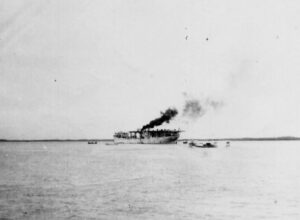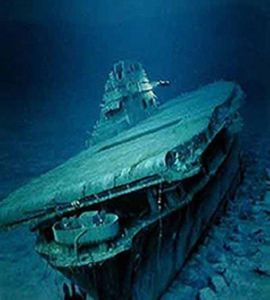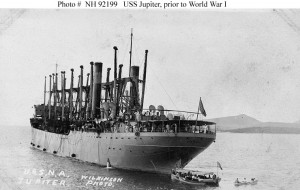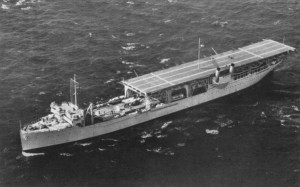uss langley
 In 1912, the coal transport ship, Jupiter, was transformed, into the US Navy’s first aircraft carrier. The ship was recommissioned USS Langley (CV-1) and was the first aircraft carrier in history. As aircraft carriers go, we would have laughed about the look of this one. This recreated coal transport ship probably should have just stayed a coal transport, but then we wouldn’t have the aircraft carriers we have today, if Jupiter had not been transformed. It all had to start somewhere.
In 1912, the coal transport ship, Jupiter, was transformed, into the US Navy’s first aircraft carrier. The ship was recommissioned USS Langley (CV-1) and was the first aircraft carrier in history. As aircraft carriers go, we would have laughed about the look of this one. This recreated coal transport ship probably should have just stayed a coal transport, but then we wouldn’t have the aircraft carriers we have today, if Jupiter had not been transformed. It all had to start somewhere.
While USS Langley was the first aircraft carrier made, it was not the first to go down in battle. That “honor” goes to HMS Courageous, on September 17, 1939, only a couple weeks after World War II in Europe began. On that day, German U-boat, U-29, sunk the British aircraft carrier with 2 of the 3 torpedoes fired striking the unfortunate carrier. Courageous went down, taking 519 of her crew with her, thereby becoming the first aircraft carrier ever sunk by a submarine. The US Navy’s first aircraft carrier, the Langley, managed to survive until February 27, 1942, when it was sunk by Japanese warplanes (with a little help from US destroyers), and all of its 32 aircraft are lost.
The USS Langley was originally launched in 1912 as the naval collier (coal transport ship) Jupiter. After World  War I, the Jupiter was converted into the Navy’s first aircraft carrier and rechristened the Langley, after aviation pioneer Samuel Pierpont Langley. Uss Langley was the Navy’s first electrically propelled ship. It was capable of speeds of 15 knots. On October 17, 1922, Lieutenant Virgil C Griffin had the great honor of piloting the first plane, a VE-7-SF, from Langley’s decks. Planes had taken off from ships before, but this was a historic moment. The prestige was short-lived, and after 1937, the Langley lost the forward 40 percent of her flight deck as part of a conversion to seaplane tender, a mobile base for squadrons of patrol bombers.
War I, the Jupiter was converted into the Navy’s first aircraft carrier and rechristened the Langley, after aviation pioneer Samuel Pierpont Langley. Uss Langley was the Navy’s first electrically propelled ship. It was capable of speeds of 15 knots. On October 17, 1922, Lieutenant Virgil C Griffin had the great honor of piloting the first plane, a VE-7-SF, from Langley’s decks. Planes had taken off from ships before, but this was a historic moment. The prestige was short-lived, and after 1937, the Langley lost the forward 40 percent of her flight deck as part of a conversion to seaplane tender, a mobile base for squadrons of patrol bombers.
The Langley was part of the Asiatic Fleet in the Philippines when the Japanese attacked on December 8, 1941. Immediately setting sail for Australia, she arrived on January 1, 1942. On February 22nd, under the command of Robert P McConnell, the Langley, carrying 32 Warhawk fighters, left as part of a convoy to aid the Allies in their battle against the Japanese in the Dutch East Indies. Then, on February 27, the Langley parted company  from the convoy and headed straight for the port at Tjilatjap, Java. About 74 miles south of Java, the carrier met up with two US escort destroyers. Then nine Japanese twin-engine bombers attacked the ship. Although the Langley had requested a fighter escort from Java for cover, none could be spared. She and the escort destroyers were virtually alone. The first two Japanese bomber runs missed their target, as they were flying too high, but the third time around they hit their mark three times. The planes on deck went up in flames. The carrier began to list, and Commander McConnell lost his ability to navigate the ship. In an effort to save his men, McConnell ordered the Langley abandoned, and the escort destroyers were able to take his crew to safety. Of the 300 crewmen, only 16 were lost. The destroyers then sank the Langley before the Japanese were able to capture it. It was necessary that they keep it out of Japanese hands. Better at the bottom of the sea that in the hands of the Japanese.
from the convoy and headed straight for the port at Tjilatjap, Java. About 74 miles south of Java, the carrier met up with two US escort destroyers. Then nine Japanese twin-engine bombers attacked the ship. Although the Langley had requested a fighter escort from Java for cover, none could be spared. She and the escort destroyers were virtually alone. The first two Japanese bomber runs missed their target, as they were flying too high, but the third time around they hit their mark three times. The planes on deck went up in flames. The carrier began to list, and Commander McConnell lost his ability to navigate the ship. In an effort to save his men, McConnell ordered the Langley abandoned, and the escort destroyers were able to take his crew to safety. Of the 300 crewmen, only 16 were lost. The destroyers then sank the Langley before the Japanese were able to capture it. It was necessary that they keep it out of Japanese hands. Better at the bottom of the sea that in the hands of the Japanese.
 Following the first successful airplane flight by the Wright brothers on Dec 17, 1903, the world changed dramatically…as did the way we fought wars. Of course, just because the Kitty Hawk broke free of the gravitational pull of Earth on that day, did not mean that we went straight to jets. Nevertheless, by the 1920s, airplanes were more common. With this change in travel and maneuverability, came the ability to use these new weapons in warfare. While it took time to develop airplanes to the ability needed to use in a war, in all reality, warfare was forever changed on that day.
Following the first successful airplane flight by the Wright brothers on Dec 17, 1903, the world changed dramatically…as did the way we fought wars. Of course, just because the Kitty Hawk broke free of the gravitational pull of Earth on that day, did not mean that we went straight to jets. Nevertheless, by the 1920s, airplanes were more common. With this change in travel and maneuverability, came the ability to use these new weapons in warfare. While it took time to develop airplanes to the ability needed to use in a war, in all reality, warfare was forever changed on that day.
The United States quickly became interested in aerial warfare, and began work on developing the planes and providing training for the pilots who would fly them. In August of 1910, Jacob Earl Fickel did the first experimenting, with Glenn Curtiss shooting a gun from an airplane. At that time, planes couldn’t easily fly across oceans like they can now, so if they were to be used in warfare, they would have to be transported to the war zone somehow. That brought about the expirements to see if it was practical to take off and land on a ship. I have to wonder just how many failed attempts they had before civilian pilot Eugene Ely successfully took off from a wooden platform installed on the scout cruiser USS Birmingham on November 14, 1910 near Hampton Roads, Virginia. This exceptional pilot successfully took off, and then landed safely on shore a few minutes later. Several months later on January 18, 1911, he also successfully landed on a platform on the USS Pennsylvania in San Francisco harbor.
Now that they knew it could be done, it was time to find a ship to be the carrier full time. Enter the USS Jupiter. The USS Jupiter was a collier ship, which is a bulk cargo ship, from 1913 to 1920. At that point, it was  decided that the USS Jupiter would be decommissioned, and converted into the first aircraft carrier in history. Once the work was finished, the USS Jupiter became the USS Langley on April 11, 1920 and was recommissioned as an aircraft carrier on March 20, 1922. Her first executive officer felt right at home on the new ship, because Commander Kenneth Whiting, who was a former submarine commander turned aviator, had been transported to England by the collier Jupiter. Whiting, who earned the title “Father of the Aircraft Carrier,” was the last naval aviator to take training personally from Orville Wright…bringing things full circle so to speak…but the story never really ends does, now does it.
decided that the USS Jupiter would be decommissioned, and converted into the first aircraft carrier in history. Once the work was finished, the USS Jupiter became the USS Langley on April 11, 1920 and was recommissioned as an aircraft carrier on March 20, 1922. Her first executive officer felt right at home on the new ship, because Commander Kenneth Whiting, who was a former submarine commander turned aviator, had been transported to England by the collier Jupiter. Whiting, who earned the title “Father of the Aircraft Carrier,” was the last naval aviator to take training personally from Orville Wright…bringing things full circle so to speak…but the story never really ends does, now does it.

